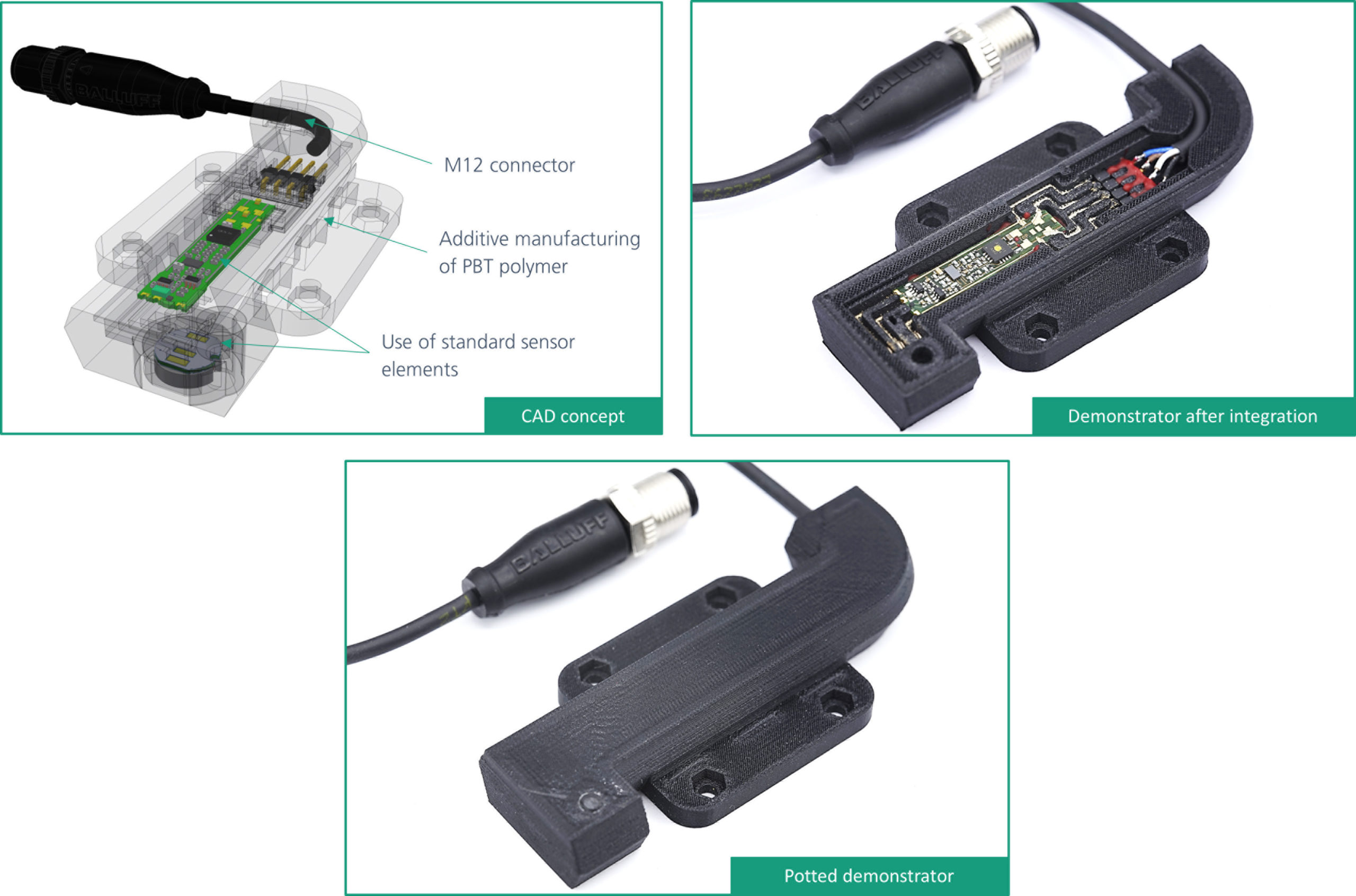One of the many Holy Grails of 3D printing is the ability to 3D print fully functional items in a single build process. Companies like Inkbit and Sakuu are after just such a goal with their multi-material processes. However, it may not require completely new 3D printing methods, such as theirs, to produce such functional objects as electronic devices. A research team from the Centre for Additive Production at the Fraunhofer Institute for Manufacturing Engineering and Automation (IPA) has demonstrated the ability to manufacture a sensor using a single-material deposition technique from ARBURG.
The team at Fraunhofer IPA pursued the production of an inductive proximity sensor directly within its casing. These cylindrical devices typically consist of a coil, circuit board, and plug within a metal shell. They can be used to measure the distance of a metal object in industrial manufacturing and other applications. However, due to the standard, mass produced shape of the sensors, they can’t always fit ideally into a given environment.
The ability to 3D print complex, multi-material goods has a range of benefits. In addition to reducing labor steps, additive manufacturing (AM) of such items could enable the mass customization of electronics or complex geometries that could improve the performance of the device. For instance, by integrating a smartphone battery and antenna directly into its polymer casing, the phone could be made smaller and lighter weight, while increasing energy density or communication range.

Freeformers in sizes 200-3X and 300-3X process plastic granulates, as also used in injection molding. Image courtesy of Arburg.
In the case of a proximity sensor, Fraunhofer IPA suggested that it could be possible to integrate one directly into a robotic gripper to make fore more intelligence handling of items in a production line. To demonstrate this possibility, the Fraunhofer team worked with a Freeformer 3D printer from ARBURG, which uses a proprietary method to melt plastic granules and deposit them onto a print bed, as well as automation firm Balluff GmbH.
It was necessary for the researchers to use a plastic with high dielectric strength and flame-retardant properties, leading them to plastic polybutylene terephthalate (PBT). While PBT is a standard injection molding material for electronic casings, it is not used in 3D printing. Here, ARBURG was able to demonstrate one of the strengths of the Freeformer, which processes injection molding pellets over plastic filament and, thus, has access to a much broader range of materials.

Fraunhofer IPA’s 3D printed sensor, including coil, circuit board, and plug within plastic casing. Image courtesy of Fraunhofer IPA.
The team 3D printed the part, leaving openings in which outside components could be integrated during the fabrication process. The machine was programmed to stop where necessary so that the coil, circuit board, and plug could be inserted into the printed part. Meanwhile, a dispenser applied the silver conductor tracks within the casing. Once these steps were complete, the Freeformer printed over the openings.
Altogether, Fraunhofer created 30 customized sensors and ran them in standard operating environments, showcasing their ability to withstand changes in temperatures and vibrations. The devices were additionally waterproof and could pass an electrical insulation test. The project, dubbed “Electronic Function Integration in Additively Manufactured Components”, lasted 18 months and the team is now working with ARBURG to explore further uses for conductive plastics.
Subscribe to Our Email Newsletter
Stay up-to-date on all the latest news from the 3D printing industry and receive information and offers from third party vendors.
You May Also Like
Further Understanding of 3D Printing Design at ADDITIV Design World
ADDITIV is back once again! This time, the virtual platform for additive manufacturing will be holding the first-ever edition of ADDITIV Design World on May 23rd from 9:00 AM –...
3D Printer Maker EVO-tech Reborn as NEVO3D — Once More With Feeling
EVO-tech was a 3D printing service and original equipment manufacturer established in 2013 and based in Schörfling am Attersee, Austria. The company produced high-quality material extrusion systems featuring linear bearings,...
3D Systems Brings 3D Printed PEEK Cranial Implant to the U.S. with FDA Clearance
For more than 10 years, 3D Systems (NYSE:DDD) has worked hand-in-hand with surgeons to plan over 150,000 patient-specific cases, and develop more than two million instruments and implants from its...
CDFAM Returns to Berlin for Second Annual Symposium
The second CDFAM Computational Design Symposium is scheduled for May 7-8, 2024, in Berlin, and will convene leading experts in computational design across all scales. Building upon the first event...































